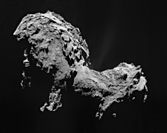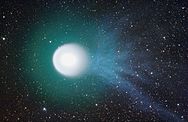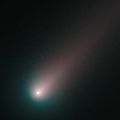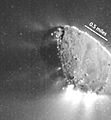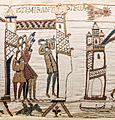Comet facts for kids
|
|||
Comets – nucleus, coma and tail:
|
A comet is a space object made of ice, dust, and rock. It's like a giant, dirty snowball. When a comet gets close to the Sun, it heats up. This causes it to release gases and dust, a process called outgassing.
This outgassing creates a bright cloud around the comet, called a coma. Sometimes, it also forms a long, glowing tail. These amazing sights are caused by sunlight and the solar wind pushing on the comet's core.
The solid center of a comet, called the nucleus, can be from a few hundred meters to tens of kilometers wide. The coma, or atmosphere, can be huge, up to 15 times the size of Earth! If a comet is bright enough, you can even see it from Earth without a telescope. People have been watching and recording comets for thousands of years.
Some comets, called periodic comets, return to our view again and again. Others, known as non-periodic comets, only visit once. As of 2014, we know about 5,253 comets, and we keep finding more. However, this is just a tiny part of all the comets out there in the outer Solar System.
About one comet each year is bright enough to be seen with the naked eye. Very bright ones are called "great comets." Spacecraft have even visited comets. For example, the European Space Agency's Rosetta landed a robot on 67P/Churyumov–Gerasimenko. NASA's Deep Impact blasted a hole in Comet Tempel 1 to study what's inside.
Contents
What Are Comets Made Of?
The Comet's Core: The Nucleus
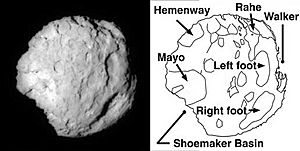
The solid, central part of a comet is called its nucleus. Comet nuclei are a mix of rock, dust, water ice, and frozen gases. These gases include carbon dioxide, carbon monoxide, methane, and ammonia. Because of this mix, comets are often called "dirty snowballs."
However, some comets have more dust than ice. These might be better described as "icy dirtballs." In 2014, scientists suggested that comets are like "deep fried ice cream." This means their outer layer is made of dense, icy crystals mixed with organic compounds. The ice inside is colder and less dense.

The surface of a comet's nucleus is usually dry and dusty. This suggests that the ice is hidden under a crust several meters thick. Besides the gases, comet nuclei also contain different organic compounds. These can include methanol, hydrogen cyanide, and formaldehyde.
In 2009, scientists found the amino acid glycine in comet dust. This dust was collected by NASA's Stardust mission. Amino acids are the building blocks of life. In 2011, studies of meteorites found on Earth suggested that parts of DNA and RNA might have formed on asteroids and comets.
The outside of comet nuclei is very dark. They reflect very little light, making them some of the least reflective objects in the Solar System. The Giotto space probe found that Halley's Comet's nucleus reflects only about four percent of the light that hits it. For comparison, asphalt reflects seven percent.
How Comets Move Around the Sun
Most comets are small Solar System bodies that travel in long, stretched-out elliptical orbits. This means they come close to the Sun for part of their journey. Then, they swing far out into the distant parts of the Solar System. Comets are often grouped by how long it takes them to complete one orbit. The longer the orbit, the more stretched out their path is.
How Comets Affect Earth
Comets and Meteor Showers
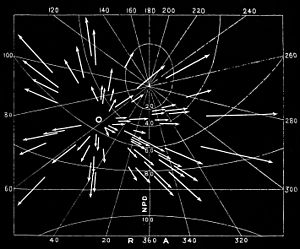
As comets release gas, they also leave behind a trail of solid debris. This debris is too large to be pushed away by sunlight or the solar wind. If Earth's orbit crosses through this trail of debris, we see meteor showers. This happens when small pieces of comet dust burn up in our atmosphere.
For example, the Perseid meteor shower happens every year between August 9 and 13. This is when Earth passes through the path of Comet Swift–Tuttle. Halley's Comet is the source of the Orionid shower in October.
Comets and Life on Earth
Many comets and asteroids crashed into Earth when it was very young. Many scientists believe that comets brought a lot of the water that now fills Earth's oceans. This might have happened about 4 billion years ago.
Scientists have found many organic molecules in comets. This has led to ideas that comets might have brought the basic ingredients for life to Earth. They might have even brought life itself. It's also thought that comet impacts have delivered a lot of water to Earth's Moon over time. Some of this water might still exist as lunar ice.
How We Find Comets
You can discover a comet using a wide-field telescope or even binoculars. However, you don't always need special equipment. Many amateur astronomers find "sungrazing" comets online. They do this by looking at images from satellite observatories like SOHO. SOHO's 2000th comet was found by an amateur astronomer in 2010.
Famous Comets
- Halley's Comet
- Hale-Bopp
- Shoemaker-Levy 9
- Ikeya seki
The History of Comets
In ancient times, people were often scared of comets. They didn't know what these bright objects were or where they came from. Some thought comets were fireballs sent by gods or demons to bring bad luck or destroy Earth. They believed that every time a comet appeared, something terrible would happen.
Later, Edmond Halley figured out that some comets are "periodic." This means they return after a certain number of years. This led to the first prediction of a comet's return, which was Halley's Comet, named after him.
Isaac Newton also studied comets. He realized that comets make U-turns around the Sun. He asked his friend Edmond Halley to share this idea in his famous book, Philosophiae Naturalis Principia Mathematica. Before Newton, people thought comets flew into the Sun and then a new one came out from behind it.
All this new knowledge helped people understand comets better. But even with science, some people still thought comets were messages from the gods. In modern times, space probes have visited comets to learn even more about them.
Related pages
Images for kids
-
A comet was mentioned in the Anglo-Saxon Chronicle that allegedly made an appearance in 729 AD.
-
Hubble image of Comet ISON shortly before perihelion.
-
Halley's Comet in 1910
-
Halley's Comet appeared in 1066, prior to the Battle of Hastings, and is depicted in the Bayeux Tapestry.
-
Page from a treatise by Tycho Brahe depicting his geocentric view of the Great Comet of 1577
See also
 In Spanish: Cometa para niños
In Spanish: Cometa para niños



